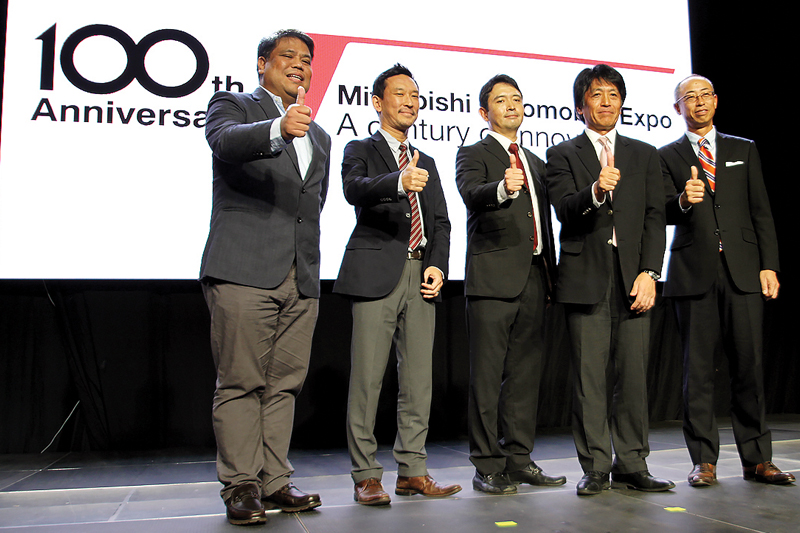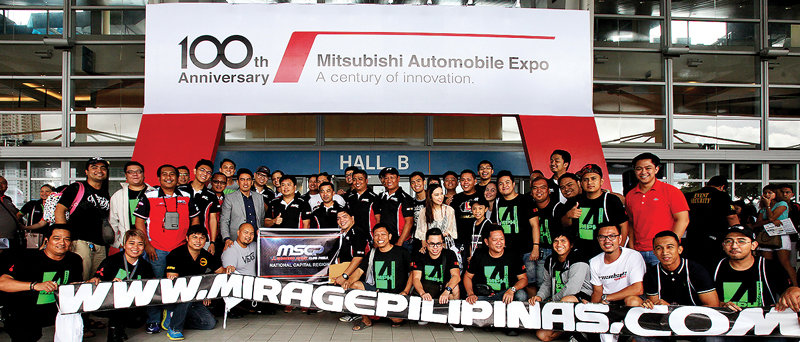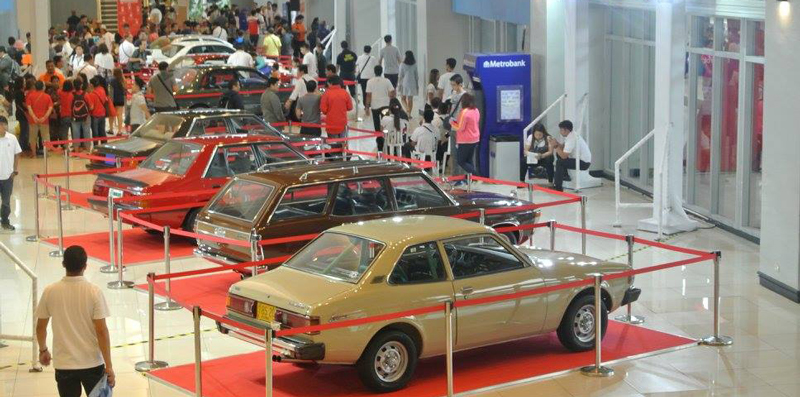Mitsubishi; Marking a century of making history

Present during the media program on opening day were (L-R) MMPC FVP for Vehicle Sales & Marketing Froilan Dytianquin; Senior Adviser Taichi Nakajima; EVP for Marketing Shigeru Ogura; MMPC President and CEO Yoshiaki Kato; and EVP, Treasurer and CFO Hirofumi Shibata
MANILA, Philippines — Over the weekend, Mitsubishi fans and automobile enthusiasts trooped to the World Trade Center in Pasay City for a comprehensive glimpse at the past, present, and future of the Japanese carmaker via its “100 Years Expo.”
It might be hard to believe that the Minato, Tokyo-headquartered brand has been at it for a century now, but its first car, the Model A, saw the light of day way back in 1917. That European-inspired automobile holds the distinction of being the first mass-produced vehicle in Japan – with only 22 units made at the company’s Kobe shipyard until 1921. Sadly, only replicas and photos of that historic line survive, but Mitsubishi still boasts a rich collection of milestone vehicles and memorabilia which testify to the company’s drive for innovation in mobility.
This historical arc of innovation can be realized most tangibly with a visit to Okazaki in Japan. Some 90 minutes via Shinkansen (or bullet train) from Tokyo, and nestled in the picturesque Aichi Prefecture, the Mitsubishi Auto Gallery (MAG) is a comprehensive compendium of vehicles that have truly left indelible marks in the history of mobility. Established in 1989 and situated at Mitsubishi Motors’ own Engineering Center, the 1,100-sqm. MAG not only enshrines landmark vehicles from the three-diamond brand, but affords a closer look at design trends and concepts, competition cars, engines, miniatures, and most anything an aficionado can ever want to behold.
Mitsubishi Motors Philippines Corporation (MMPC) brought a free slice of the MAG experience to the country with its lineup of vehicles at the expo. Shipped here were a replica of the 1937 PX33, the 1985 Paris-Dakar Rally-winning Pajero #189, a 2005 WRC Lancer Evolution, and the Outlander PHEV which was victorious at the 2015 Baja Rally.
At MAG, another section is devoted to bicycles, motorcycles, scooters, and three-wheelers – modes of transportation which became popular choices for post-war Japan. Mitsubishi reports that their production and development lay the foundation for the company’s eventual, decisive entry into the passenger car market. The Silver Pigeon C-10 scooter, made in 1946 at Nagoya, “symbolized the beginning of a peaceful era, and it was well received by the Japanese,” according to company literature. In the following year, Mitsubishi’s aircraft engineers reworked excess duralumin previously earmarked for use in planes to assemble a lightweight bicycle, named Juji-go. Also in 1946, the Mizushima, a small three-wheel truck, was commissioned for delivery service across Japan.

Several Mitsubishi car clubs celebrated the triple-diamond brand’s centennial
Here in the Philippines, the three diamond-emblem brand has long resonated – with a presence that formally began in 1963 via the establishment of Chrysler Philippines Corporation (the US marque was a longtime partner of Mitsubishi). In October 1978, the company name was changed to Canlubang Automotive Resources (CARCO), and manufacturing operations were consolidated in Cainta, Rizal.
At the start of 1987, the Philippine Automotive Manufacturing Corporation (PAMCOR) was incorporated by Mitsubishi Motors Corporation and Nissho Iwai Corporation, with an authorized capital of P300 million. A significant, P600-million plant expansion program was completed in 1992. By July 1994, cumulative production in 30 years had reached a milestone 250,000 units; in 1996, the same year PAMCOR was officially renamed to MMPC, this number breached 300,000.
The now-iconic Mitsubishi Adventure was first unveiled in 1998, and the Asian utility vehicle (AUV) quickly grabbed segment leadership. The year after, despite the backdrop of the so-called Asian flu that doused economic activity, MMPC regained first place in the automotive industry.
In 2001, Mitsubishi reached the 400,000 mark in cumulative local sales – the same year MMPC obtained an ISO 14001 certification (Environmental Management System) from Product Service Asia Pacific as a nod to the company’s commitment to environment protection.
By 2009, MMPC had produced its 500,000th unit and introduced the locally made Mitsubishi Lancer. In 2013, Mitsubishi celebrated 50 years in the Philippines and continued to stamp its mark as longest-staying automotive brand here.
As it prepared to move to a new location in Sta. Rosa, Laguna, the last vehicle rolled out of MMPC’s Cainta plant in December of 2014. The new MMPC factory was unveiled in January 2015; this same facility would produce the 600,000th unit of the company.

Various models of Mitsubishis sold in the Philippines were on display at the main lobby of the World Trade Center
But beyond the numbers, Mitsubishi has endeared itself to Filipinos by figuring heavily in our lifestyle and history. Take the diminutive Minica, that beloved subcompact of subcompacts, or the storied Colt/Galant series (Who hasn’t heard of the Sigma?). Then to fill in the gap between the Minica and the Colt, the company introduced the Lancer and Mirage series in 1973. The former was equipped with either a 1.2-liter or 1.4-liter power plant. An alpha-dog variant, the 1.6-liter GSR, later made its entry. According to company literature, the GSR “played an active role in international rallies to strengthen the reputation of Mitsubishi as an active player in rally sports.” The highly touted, sporty Celeste (a few of which still ply our traffic-choked roads) also takes its place in this pantheon of wheeled heroes.
And did you know that for a time, under license, Mitsubishi also produced the Jeep? The company stresses that it was the substantial experience manufacturing the iconic vehicle that helped it to develop the Pajero later on. The carmaker produced the J10 in 1955, which featured both the Mitsubishi logo and the Willys name above the classic grille. This was preceded by a knockdown production of the CJ3A in 1952. The first Pajero prototype rolled out in 1973. It understandably bore similarities with the Jeep, but was a true step towards a distinctly Mitsubishi sports ute – and a reputation forged in motorsports victories with its famous SUV marque.
In a prepared speech delivered to members of the Philippine media late last year who visited the Mitsubishi Motors Corporation facilities in Japan, chairman, president and CEO Osamu Masuko expressed nothing but gratitude and hope for the story of Mitsubishi in the Philippines. He explained that while the Sta. Rosa, Laguna factory of MMPC presently boasts an annual production output of 50,000 units yearly, “that capacity can be expanded to 100,000 units.” He continued: “MMPC has started investment of about P4.3 billion implemented to expand its passenger car production line.”
The increased activity through the production of the locally assembled Mirage models is expected to up MMPC’s total workforce to about 1,400, added the executive. “We would like to contribute to the development of the automotive industry in the Philippines through promotion of local production, expansion of local parts procurement, and promotion of employment... when the stamping plant is finished, headcount will be about 1,500.”
For Mitsubishi, the Philippines continues to be an attractive venue – one that makes sense to do business in. Masuko said the country’s large, young population base is a definite advantage, in addition to a steady political and economic outlook.
Truly the rich history of Mitsubishi in the Philippines is matched only by the limitless possibilities of its future.



















